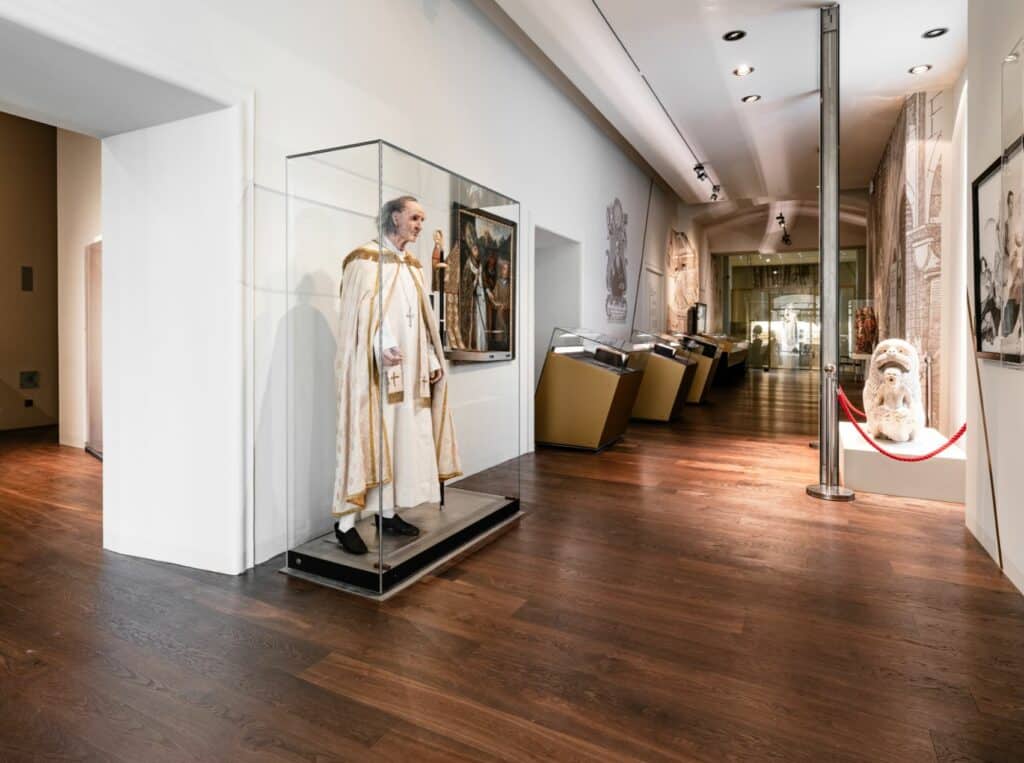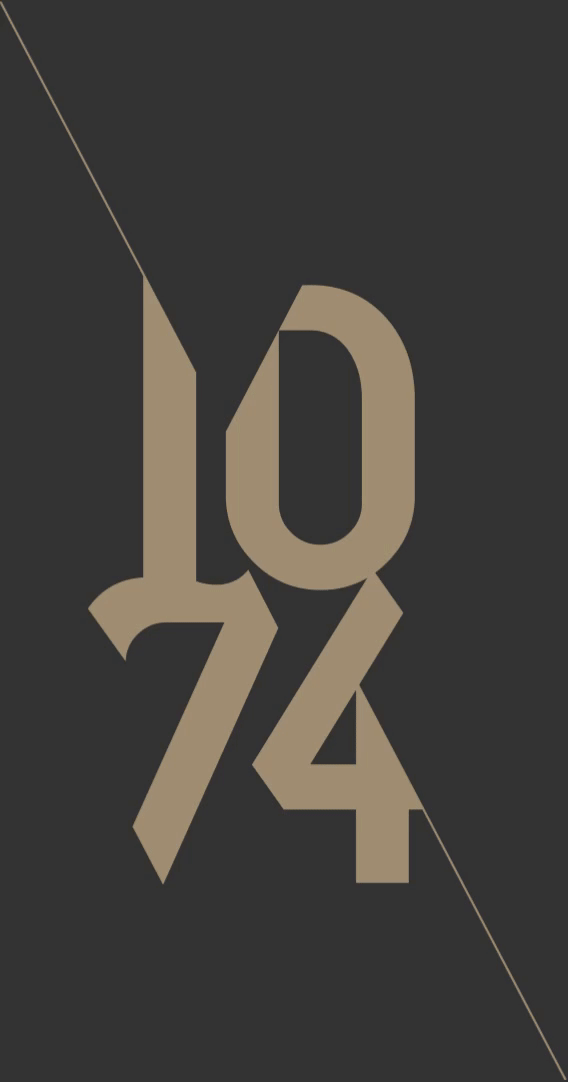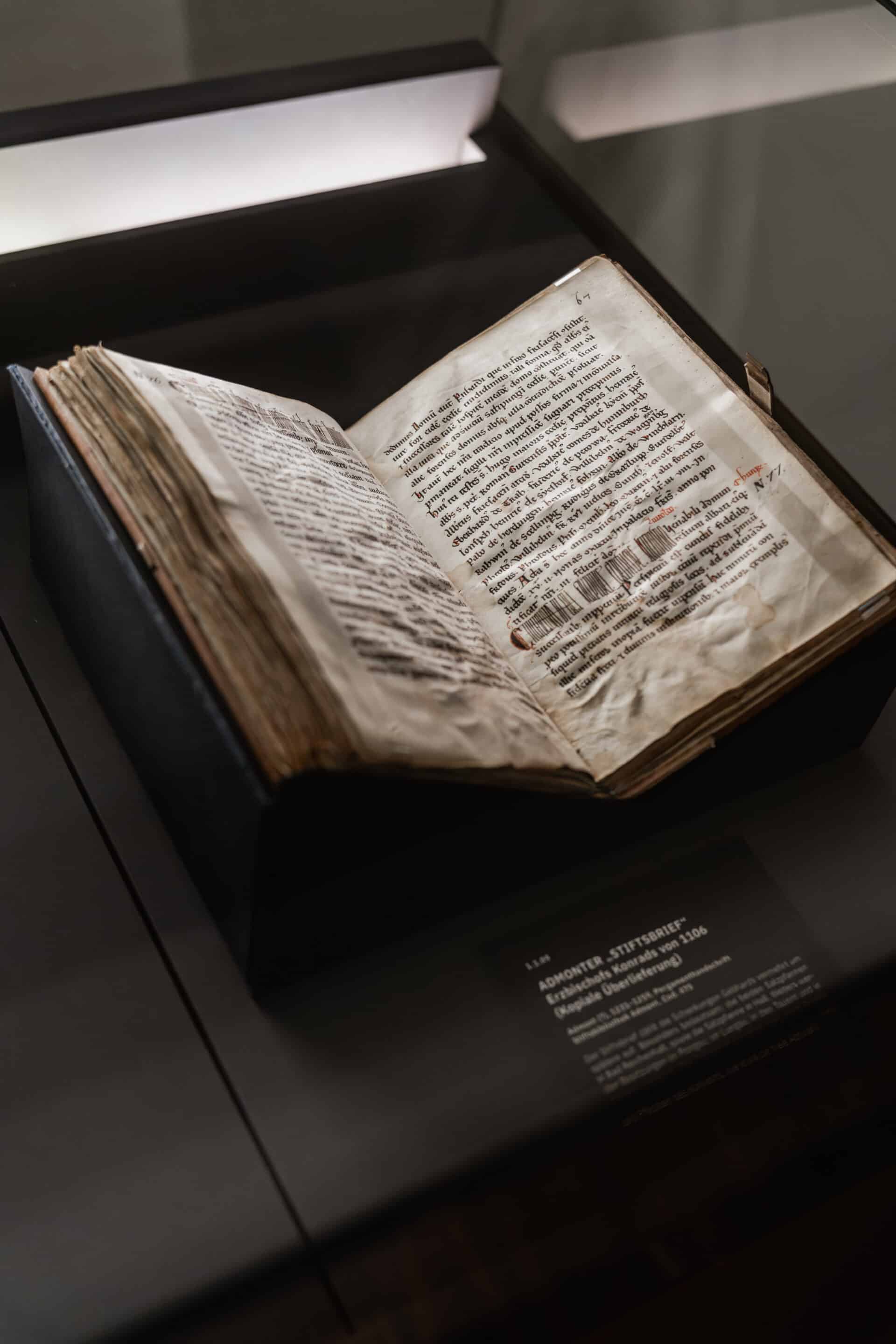

Admont 1074 - A Journey Through the History of the Monastery
Christian Rapp / Alexander Kada
In spring 2024, a special exhibition about the history and development of the monastery will open on the first floor of the museum building. The exhibition represents a journey through almost a millennium and displays fascinating objects, from illuminated manuscripts from the Middle Ages to a contemporary photo collage by Lois Renner, from charcoal samples to precious pectorals.
The variety of objects suggests a restrained, yet supportive design. The joy of perception should take centre stage. Floor-to-ceiling display cases hold spectacular objects, large and small formats alternate, large-format prints on the walls and audio stations convey a captivating atmosphere and allow visitors to immerse themselves in different eras. Gold-coloured, metal surfaces, used in various positions, serve to divide rooms and large display cases. "Beauty is created when the outside becomes an image of the inside" - this idea symbolises the design of the special exhibition. You wander through the exhibition without straining yourself, as if you were being carried along by a gentle tailwind, and are constantly amazed.


We begin our journey through time with the foundation of the monastery and the legends that surround it. Every era has reinterpreted these and their central protagonists. In addition to freely invented replicas of the founder Hemma von Gurk and Archbishop Gebhard of Salzburg, we can also see the scientifically substantiated reconstruction of the archbishop's head. We look Gebhard in the face, as it were, like a contemporary. Even if such a reconstruction can only ever be an approximation, one has the impression of being able to recognise the psychological strain on the archbishop's features during the Investiture Controversy. Admont, founded by Gebhard and a monastery loyal to the Pope, was repeatedly attacked and plundered by Salzburg's enemies. A nun's convent, founded in 1121, existed until the 16th century and is well documented in illustrated manuscripts, correspondence, and documents, is of great importance to us. Another section of the exhibition deals with Admont's heyday in the late Middle Ages, epitomised by the work of the Abbots Irimbert, Henry II, and Engelbert. They symbolise the diverse roles that monastery leaders could play in academia, the clergy, and politics: Irimbert was regarded as a strict reformer of the order; Henry II was the highest financial official in Styria as Landschreiber and then rose to become provincial governor; Abbot Engelbert was one of the most important Austrian scholars of his time.
This impressive era was followed by a crisis of faith and the Reformation, which signalled the end of the nun's convent in Admont and also threatened the monastery. This revolutionary period is illustrated by early printed books, through which the Reformation spread. The new upswing of the monastery during the Counter-Reformation can be seen in some of the particularly impressive exhibits in the exhibition: Furnishings from the legendary Stone Hall can be seen, as well as precious sacred artifacts and magnificent paraments from the workshop of Benno Haan.
This is followed by the ups and downs of the Josephine and Napoleonic periods as well as the fire of 1865. Historical stereo photos allow visitors to visualise the "old" Admont before the fire and the reconstruction of the church. Documents, photos and letters record the major upheavals of the 20th century, the severe economic crisis of the 1930s and the dissolution and expropriation of the monastery by the National Socialists. Books from the library had to be delivered to the German Research Institute for Food and Nutrition, which was affiliated to the Dachau concentration camp, as can be seen from the corresponding stamps within the books.
In autumn 1945, a few months after the end of the Second World War, Abbot Bonifaz Zölß and the monastic community returned to Admont from exile. After the hardships associated with returning, a phase of prosperity emerged in all areas of monastery life, which has essentially continued to the present day. The Gebhard chalice, created by the sculptor Hellmut Gsöllpointner in the late 1950s, is an example of the period of reconstruction. It has a simple, elegant form and contains the figure of Gebhard, which is modelled on a Romanesque miniature from the Admont library in a steel cut. The following section of the exhibition is dedicated to scientific curiosity, research, collecting and the dissemination of knowledge, illustrated by books from the library and objects from the natural history collection. They reflect the broad interests and passions of the monks. The leading objects in this area are two globes that go back to the geographer and cartographer Gerhard Mercator, who is regarded as the founder of modern cartography. A pair of globes of this kind can only be found in Austria in the National Library. A look at Admont's school history shows that knowledge was not only deepened and increased in Admont, but also passed on, which began with the education of the clergy, but also of boys from the laity, as early as the founding period.
Scientific research and teaching, as well as pastoral work, require an economic basis. A further section of the exhibition, which is dedicated to historical and contemporary economic enterprises, testifies to this. A magnificent charter from 1443 documents the connection between property and rule as it was until 1848. A second document, which records the sale of a property, shows that the monastery was repeatedly forced to finance the sovereign's wars. A miners' banner from the late 17th century depicting miners and an impressive picture of the interior of a hammer mill, painted by Augustin Kurtz-Gallenstein, illustrate the mining activities of Admont Abbey, which were always important for the entire region, whether it was salt mining in the Middle Ages, iron smelting in the early modern period, or magnesite mining in the 20th century.
The following exhibition room takes an existential turn and is dedicated to the themes of death, life and resurrection, with the curatorial team deliberately juxtaposing Baroque paintings and prints with contemporary artistic works such as those by Siegfried Anzinger in order to emphasise the continuity of this existential theme as well as the diversity of its interpretations. Admont has a number of works depicting the process of dying, objects commemorating the dead and books containing dances of death.
At the end of the tour, we invite visitors to switch from looking to listening. A number of pieces of music written in connection with the monastery will be played, as well as literary texts written about the monastery, including by Caroline Pichler, Peter Rosegger, Paula Grogger and Bodo Hell. The naturalist and travel writer Johann August Schultes was enthusiastic about Admont at the beginning of the 19th century when he stopped off in Admont with some companions on his journey to the Grossglockner. He almost got stuck here, he said, like Odysseus of Kirke, because a different "favourite object" - the landscape, the library, the surrounding flowers, the sound of the church organ - captivated him and his fellow travellers. The abbey's museums of ancient and contemporary art and natural history would certainly be additional favourite objects for Schultes and his travelling companions today, which the anniversary exhibition aims to make accessible.
Catalogue for the anniversary exhibition in 2024
1074 - Benediktinerstift Admont. 950 Jahre lebendiges Kloster, Benediktinerstift Admont (ed.), 10 authors, 11 essays, extensive, richly illustrated object section, 196 pages, Vienna: Böhlau Verlag 2024, ISBN: 978-3- 205-21965-1 (print), 978-3-205-21966-8 (e-book).
To accompany the anniversary exhibition, a catalogue will be published in bound form and as an ebook edition in 2024. The catalogue is divided into two parts. The essay section primarily discusses historical issues relating to the history of the abbey and the abbey's collections, as well as taking a closer look at specific topics relating to the exhibition. The extensive object section, with numerous illustrations, lists the high-calibre exhibits, some of which have never been shown before and almost all of which come from the abbey collections. On 196 pages, it is thus possible to experience the journey through the 950-year history of the abbey in book form as well as visiting the exhibition.






